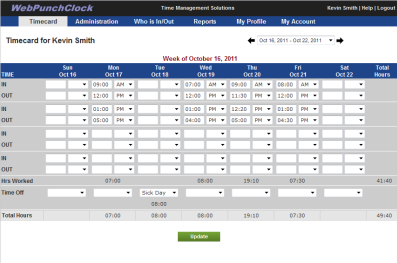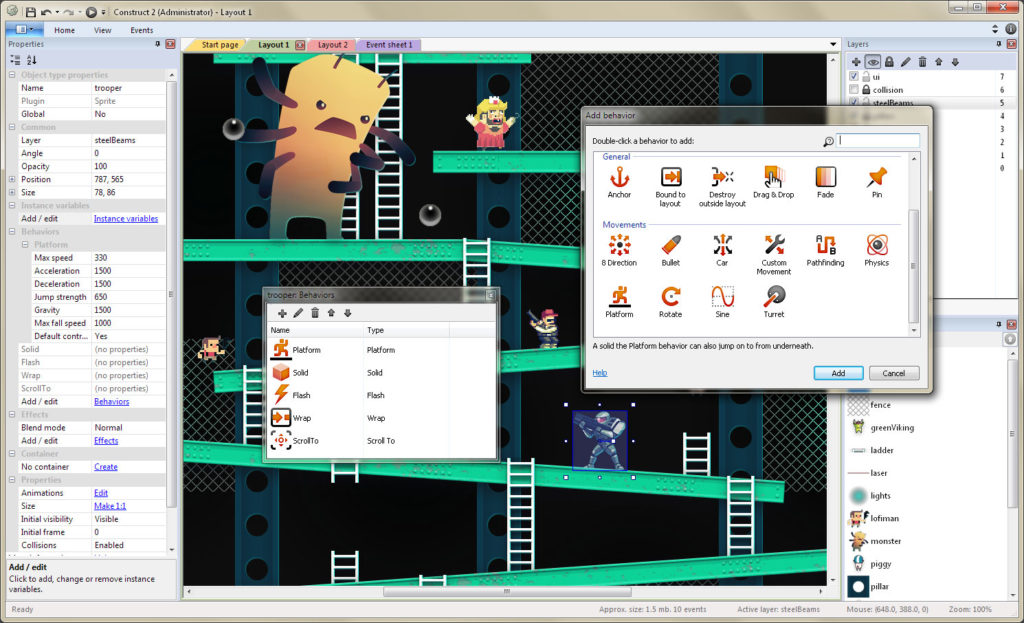Limit user’s choice, eliminate features, make it stupid easy to use. Welcome to the era of fun-centric products.
Let’s talk about fun
Fun is a relatively new term in the UX jargon, a word that is usually associated with games or, in its business orientation, gamification.
The need for fun in products arises from the notion that people would rather use product A over product B, albeit both with a similar offering, only because the first is more “fun” to use.
Fun can be interpreted in many ways. Take this punch office clock software as an example. This is a software program designed by engineers for the sole purpose of punching hours at the office digitally.
A simple design touch and the UI would improve it significantly. Let’s call this “UI fun,” and its design purpose is to help people use the product more efficiently. Improving the UI would probably max out that product’s fun potential.
However, as some tremendously popular apps have proven, digital products, traditionally “problem-solving” products, can be designed around fun experiences solely for entertainment purposes.
The fun-centric design approach
Designers working with this mindset would constantly ask themselves how their product can be more fun to use. Counterintuitively, fun is often achieved by limiting a user’s choice and restraining users to strict rules.
Instead of having users browse in a big pool of profiles, push them a line of profiles to sort though linearly (Tinder).
Build an ordinary messaging protocol, combine it with a “limiting” game mechanic (message disappears in 10 seconds), make a billion-dollar company (Snapchat).
Fun potential
What products are eligible to be fun-centric products? Almost anything that allows for some creativity and skill building.
Think of a website builder, like Wix or Squarespace. This is a product with big fun potential. Everybody loves to build things. Now let’s add limiting rules to it. Imagine, that instead of rulers, grids and design features, there’s only one button that randomizes and merges awesome website templates together. The limitations of design from the user perspective are big, but the elements always work well together and results are surprising.
This is a fun-centric approach to design, and I bet that as we speak 5 startups are doing just that.
The method of making fun-centric products
Fun-centric products are hard to design. Mainly because fun is a subjective and immeasurable thing. A fun thing for one would be another’s nightmare.
So what is there to do?
- Play games
Didn’t see this one coming, did you? To make fun products you have to get better at understanding and analyzing fun. Games are textbooks for fun. Their main purpose, sometimes only purpose, is to be enjoyable. As such, they use a lot of fun patterns, rules and mechanics that are proven to be fun.
Think Tinder. Tinder’s core mechanic is sorting to the left and right, a mechanic based on pattern recognition. Very much like Solitaire or Candy Crush. We are wired to find these types of sorting activities fun. On top of Tinder’s core mechanic are other fun patterns borrowed from the gaming world, such as variable rewards, winning conditions, progression and more.
Analyze games as you play them. Ask yourself what “fun patterns” are at play, how does the game persuade you to keep on playing, what is the core fun mechanic?
Now that you’ve played tons of games for the sake of research, pick a few favorite mechanics and proceed to the next step.
- Make a boring product – fast
The best way to create a fun product is by making a boring product and slowly turning it into fun. This effectively means that whatever idea you are thinking of, be it a new dating app with a twist, an ecommerce app, or an education app, this idea of yours has to be built in days. I’m not talking about an Invision prototype; I’m talking about a functioning piece of software.
The best way of achieving this is using one of the “no-code” tools for creating games.
My personal favorite is Construct 2, but there’s also Stencyl, Game Maker and others.
Build it ugly, fragile, doesn’t matter, as long as it is out in days so you can continue to the next step.
- Playtest your product
Is what I’m working on fun? This is a haunting question that you cannot answer! By now you are so much involved/in love with your prototype that subjectivity is out the window. The only way to know if your product is fun is when other people’s actions tell you so.
Playtesting is a daunting phase in which your product gets trashed again and again.
You have to listen, not only to people’s mouths but also to their actions, then iterate fast on feedback and try again. Ideally, the prototype would change significantly from iteration to iteration. This could be done only if the code is nimble; therefore, I’d recommend keeping it in a game engine environment rather than in a native one.
- Make games
This whole article leads to this point. I think that every UX and product designer should have experience in building a product centered around fun.
I find it very common that UX and product designers that work in startups/tech companies have released very few products to the market, if any. And if they did, they took a specific role in the design of those products and were restricted by the business initiatives of the company.
Building a small game is your opportunity to struggle first-hand in the serious business of making a fun product, end to end. I wouldn’t just copy a working mechanic, though, and build an Asteroids clone. If you are working on a dating app, try to make a dating game. Small, with a twist. Try to make a gamified communication system like Snapchat, in a few days.
Use elements that you love from games, try it on people, iterate. Again, you don’t have to know how to write code to achieve that. Just pick your weapon of choice and start writing.
Tell me how it is going for you.
Anxious to hear.



